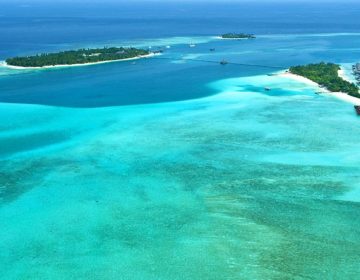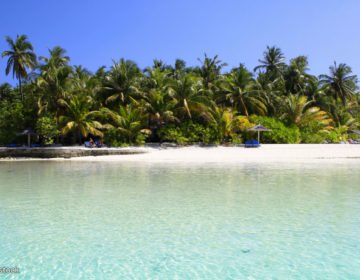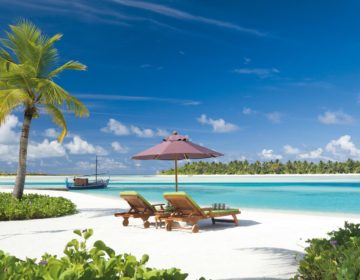There have been hundreds of shipwrecks in the Maldives throughout the centuries, but of all the recorded wrecks, six stand out above all the others.
The Corbin
The Corbin was a French ship of 400 tons which set sail from St Malo with the Croissant on May 18, 1601, in search of trade with the east. Plagued by misfortune and ill-discipline, the Corbin was destined for disaster and met its end on Goidhoo, or Horsburgh Atoll, on July 2, 1602. It was carrying a cargo of silver and attempted salvage at the time of the loss was unsuccessful.
 Goidhoo, or Horsburgh Atoll. Credit: Wikimapia
Goidhoo, or Horsburgh Atoll. Credit: Wikimapia
At the start of the journey, a bad omen occurred when the mast broke, and the crew threatened to jump ship. Sickness and desertions threatened the expedition before the boat had even begun to cross the Indian Ocean. The stifling heat had destroyed many provisions, the water was putrid, fish and meat had gone off, and was full of big worms, butter had turned to oil, and scurvy was rampant. A short stay of 15 days in Malailli, one of the Comoros Islands, vastly improved the health of the crew before they crossed the Indian Ocean.
On July 1, some reefs and islands were sighted, which were correctly recognized as the Maldives by the English pilot. The night was supposed to be spent beating about, but the Corbin was virtually left to herself. During the night, the captain was ill and in his bunk, the mate and the second mate were drunk, and the watch was asleep. In the early hours of the morning of July 2, the ship struck the reef.
Of the 40 or so survivors, one band of 12 men stole a boat and made it to India. Only four of the remainder survived the five-year captivity. One of them was Francois Pyrard, who wrote about his adventures when he returned to Europe. It wasn’t until February 1607, when an expedition from Chittagong invaded the capital, that Pyrard and his three remaining companions were taken to India and eventually returned to France. Ironically, it was the excellent cannon on board the Corbin that the raiding party was after, which eventually freed the captives.
The treatment of Pyrard and his companions by the Maldivians was uncharacteristically cruel, but their fate was largely determined by their conduct in the days following the wreck of the Corbin. All the silver and most of the precious merchandise were stowed at the bottom of the ship which, after running onto the reef was under water and irretrievable. What remained of the silver was hidden in their waistbands.
During their first night on Fulhadhoo, they hid their waistbands for fear they should be searched by the Islanders. At length, the sailors obtained little to eat and were dying of hunger, so they unearthed the coins and offered money for food, which they received. In turn, the natives would give nothing except for money, and before long the coins started to run out. In the Voyages of Francois Pyrard of Laval to the East Indies (Hakluyt Society, 1890), Pyrard wrote:
“Those who had money, and who by this means could obtain food, filled their bellies without discretion; and being in a country where the air is very unhealthy for strangers, even for those of a similar climate, they fell ill, and died one after another, nay more, in a place of receiving aid and consolation from their fellows, those who were without money and in great need came and stripped them, and took their money before they were dead, the healthy who survived fought with one another who should have it, and banded themselves two against two, and finally messmate against messmate, with so little clarity, that they would see their comrades and fellow countrymen die before their eyes without giving them any assistance or succour. I never have sight so pitiable or deplorable.”
Pyrard was taken with two other crew members to another island, Fedendhoo. Unlike the others, they had no belts of money, and although this caused some trouble at first, they found they were better off with nothing, as little by little, the natives gave them some food.
News of the wreck and the money reached Malé and commissioners were sent to Fulhadhoo to secure the wreck on behalf of the sultan. All merchandise and money from shipwrecks automatically became the property of the sultan and Maldivians were prohibited from selling anything to the shipwreck victims. When the commissioner arrived at Fulhadhoo, he demanded to know who had the money from the vessel. To get hold of it, he arrested all the inhabitants, even the women, and had their thumbs put into cleft sticks and squeezed and bound with iron clasps to see if they would confess. The villagers on the island of Pyrard’s captivity were in no trouble when it was proved they had taken nothing, for which they were grateful.
Pyrard took great pains to learn their language and by doing so was able to largely determine his own destiny and obtain insight into Maldivian society never before seen by a westerner, on which he wrote extensively.
“I have remarked that nothing served me so much, or so conciliated the goodwill of the people, the lords, and even the king, as to have the knowledge, and that was the reason why I was always preferred to my companions, esteemed as they were.”
The wreck of the Corbin may have passed unnoticed through history were it not for the historical accounts left by Francois Pyrard. His account of the wreck and ensuing captivity makes for compelling reading, and his description of life in the islands and the customs of the people make his book a valuable source of reference for historians and students of Maldivian history and culture.
The Hayston
The Hayston, a three-masted English vessel commanded by Captain Sartorius, set out from Isle-de-France (nowadays Mauritius) for Calcutta on July 1, 1819. For several days bad weather had prevented them from taking any observations and July 20 at 8:00 pm, some reefs were noticed in the gloomy darkness. There was little time to tack, and the ship struck the reef on Makunudhoo Atoll on the north-west of the Maldives. Within a quarter of an hour, there were seven feet of water in the hold, and the ship’s crew was at the mercy of the elements.
The next morning, the sailors discovered they had run onto an enormous reef, as far as the eye could see, that turned out to be covered with water on the high tide. A small islet was seen by telescope 25 km away which they called the ‘Isle of Hope.’ On the 22nd, three sailors tried to reach this isle by raft but were never seen again.
On the 24th, every sailor was employed in building a raft large enough to carry them all, but when it was nearly completed, the Lascar sailors from the west coast of India, cut the rope and sailed away. One man who tried to reach them was threatened with an ax.
The long boat was taken out from the ship but was damaged on the reef and went adrift with a woman and her two daughters, and three men, who were never heard of again. Then the barge was launched, and it was not long enough before she capsized and split on the reef.
Two more sailors, Serang, and his brother, were separated from the remaining survivors who when a raft on which they were paddling between the reef and the shipwreck was caught in the current and drifted away to the south-east. In another accident, a rope as stretched between the reef and the ship and a young boy died trying to return to the ship.
Finally, on the 26th some sailors embarked on the small dinghy and sailed for the Isle of Hope. They were discovered by fishermen from the island of Makunudhoo, and the remaining passengers were rescued. The survivors arrived in Malé on August 4 and were treated with much hospitality.
On August 10, Serang and his brother arrived in Malé. After drifting away on their raft, they spent three nights and four days out at sea and passed 11 islands before they reached they landed on an uninhabited island. They were both very weak and survived on coconuts before being rescued by a passing fishing boat. They were conducted to the island where the fishermen lived and were treated with much kindness.
On August 14, the six Lascars who stole the large raft arrived in Malé. They resorted to lies to explain the infamy of their behavior, claiming the raft had been broken, had gone adrift and the current had carried them away. Despite their treachery, they were treated equally by the sultan.
The wreck of the Hayston is noted for the humanity of the Maldivians and the generosity of the sultan. In all cases, the castaways were well provided for, and the sultan would not allow them to pay for anything in his country. Officer Schultz wrote:
“Let the Christians blush thinking that, though they profess a religion that enjoin the most tender charity, you turned out, in our minds, to be, as it were, superiors to them in the practice of virtue and humanity.”
The Ravestein
The 800 ton Dutch East Indiaman Ravestein was sailing to Jakarta from the Netherlands with a valuable cargo of gold and silver when it ran aground near Mathiveri Island in Ari Atoll on May 9, 1726. At the time of the loss, nine chests of silver and one chest of gold were recovered.
 Dutch East Indiaman Ravestein. Credit: Wikipedia Commons
Dutch East Indiaman Ravestein. Credit: Wikipedia Commons
The captain, Antony Klink, sent the rest of the crew to Malé, while he remained for one month at the island near where the vessel was lost. The arrogant conduct of Klink tested the patience of the Maldivians, in particular, Sultan Ibrahim Iskandar II (1720 – 50 AD). In a letter sent to the Dutch Governor of Ceylon, the sultan said Klink did nothing but complain bitterly of the inhabitants of the islands.
“He [the captain] expected them to work like European sailors, not taking into consideration that fact that they were not only wretched creatures who look upon the smallest service extracted from them as grievous oppression. You are well aware, gentlemen, of the nature of the islanders.”
When the captain arrived in Malé on June13, he demanded from the sultan 50 men and four large boats to save the property of the company. The sultan was outraged by this extraordinary demand and gave no answer and, in any case, was not prepared to send boats to the site as the vessel was cast away on a place to which a small boat can approach only with difficulty, as the seas were rough and the surf dangerous.
The Dutch were invited to return in the calmer months to attempt further recovery, and the crew of the shipwrecked Ravestein was returned to Ceylon with the gold and silver chests and other goods recovered from the wreck.
The Persia Merchant
One night in August 1658, five months after her departure from England, the Persia Merchant was wrecked on Maamakunudhoo Atoll while en route to Bengal. On board were eight chests of silver and probably gold from West Africa. Salvage was attempted at the time of loss but was unsuccessful.
Many were drowned, but the 50 survivors were well treated by the Islanders and after one month they were given a good boat in which they sailed to Sri Lanka. Among the survivors was captain Roger Williams and the mariner-captain Roger Middleton, who wrote an account of his adventures to his family after reaching India.
Middleton said the ship filled with water quickly, leaving the survivors with nothing and within four hours she had broken into pieces. One of the boats sunk under the ship, leaving just one other to rescue the victims. The survivors found their way by boat and broken pieces of the ship to an uninhabited island south of Makunudhoo, but without food, drink or arms. Middleton wrote:
“Being without food, wee ranged about the island. Wee found a well of watter, of which wee drank like pigeons, lifting head and harts for soe greate a mercy. Thus drinking watter, by good providence wee found coker nutt trees, which is both food and raiment, soe wee went by the sea side and found little shell fish and the like, but wanting fire wee tooke sticks and rubbed them together until they kindled, thus we lived heare ten or twelve dayes, not knowing wheather it was better for us to be seen by the Neighboring Islanders, for the ancient seamen sayd they would cut our throats. Att last there arrived three of their boats full of men, which wee dreaded but could not resist.”
The stricken castaways were taken to the island of Kuburudhoo (South Thilahunmathee) “where wee had fish and other good things, as hony and rice, on which wee fed like farmers.” For the price of a gold chain and $100 from one of the merchants, they obtained a vessel and sailed to Ceylon.
The Prazer e Alegria
The Prazer e Alegria left Lisbon, Portugal, on November 8, 1843, with 84 convicts and relief officers and others, bound for Goa, India. She reached the Cape of Good Hope with the loss of 29 convicts from scurvy and on March 16, 1844, the crew sighted several islands which the captain declared were the Maldives. With the current running at three miles an hour towards the land, the captain continued on the same course.
 Portuguese fleet in Lisbon. Credit: Almada Virtual Museum – Blogger
Portuguese fleet in Lisbon. Credit: Almada Virtual Museum – Blogger
Major de Quinhones, who was in charge of the convicts, said in a report of the disaster:
“At about 4:00pm in the evening when the ship was so near land that we could see the people distinctly; and it was then that a little boat manned by black, and with an English jack fixed at the poop came off from one of the islands. Approaching the ship, one of the Moors pointed towards a channel which lies between three or four islands. The captain hailed the Moors and told them to come on board; but seeing the convicts, they immediately parted through fear, lowering the Jack. Thus we were committed to the current, which every moment drove us nearer land, and upon a reef of coral which lies opposite the second island. The night was dark, and there was lightning; the breakers dashed incessantly on the sides of the ship, forcing her more onto the reef; at length, the rudder broke, and the ship rested, but a large leak was sprung. All of us worked the pumps, but it was impossible to reduce the water.”
The ship had struck the reef off Muli Island in Mulaku Atoll and on the morning of the 18th, the passengers and crew were transported to Muli Island without loss of life. On the following day, the cock-boat, the longboat, and a hired boat form the villagers were dispatched to procure more provisions, but all three boats were sunk by the waves. Eleven lives were lost, mostly convicts.
The 104 survivors remained on the island of Muli for five days before being transported to the ‘King’s Island.’ It took seven days sailing by day only and stopping the night at islands to reach Malé. The captain hired to Katamarans to transport the survivors to Ceylon, among whom were two ladies and three children.
The Guraidhoo Wreck
In the 16th century, a Chinese ship with a cargo of porcelain and Chinese merchandise was wrecked near the island of Guraidhoo in South Malé Atoll. The story is best told by Pyrard, who visited the island in 1605.
“I was at the island one day and saw the mast and rudder of the ship were lost there. I was told it was the richest ship conceivable. It had on board some 500 persons, men women, and children, for the Indians take the greater part of their family to sea with them. These 500 persons were nigh all drowned, and there remained but 100 saved. This ship came from Sunda (Indonesia), laden with all kinds of spices and other merchandise of China and Sunda. Judging merely from the mast of this vessel, I thought it was the largest I had ever seen, for the mast was taller and thicker than those of the Portuguese carracks; and the king of the Maldives built a shed of the length of the mast to keep it as a curiosity. I saw another mast and a top much larger than those of Portugal. Thus was I led to believe that in the Indies they build vessels larger and of better material than in Portugal or anywhere else in the world. The greatest ships come from the coast of Arabia, Persia, and Mogor, and some have as many as 2,000 persons on board.”
Old folk from Guraidhoo still talk about a wooden ship believed to be wrecked on Medhu Faru near Guraidhoo centuries ago, however, no visible remains are to be seen.
(Source: Dive Maldives: A Guide to the Maldives Archipelago by Tim Godfrey; www.broffice.gov.mv)



